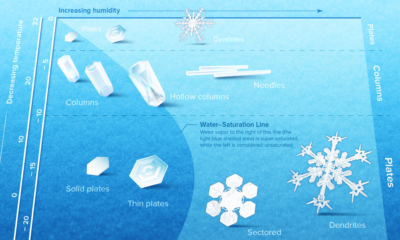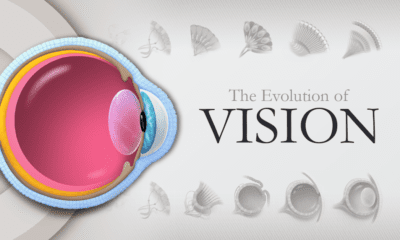Misc
Visualized: The 4 Billion Year Path of Human Evolution
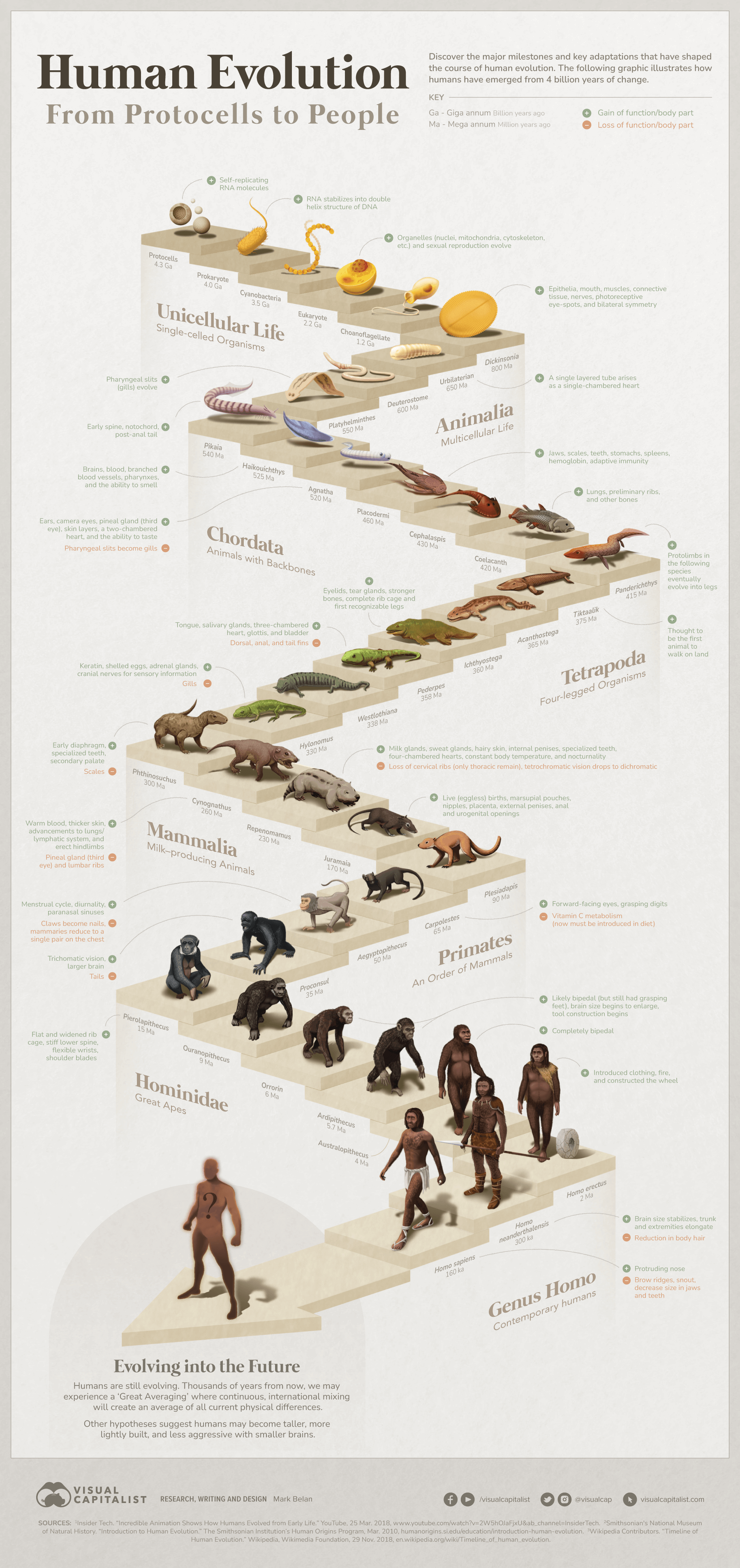
The 4 Billion Year Path of Human Evolution
The story of human evolution is a fascinating one, stretching back in an unbroken chain over millions of years.
From the tiniest protocells to modern humans, our species has undergone a remarkable journey of adaptation, innovation, and survival.
In this article, we take a look at the key developmental stages in the evolution of life on Earth that led to the emergence of Homo sapiens—us!
From Protocells to People
Evolution is the result of millions of minute mutations over millions of years, but the evolutionary process that created us can bucketed into a few key categories.
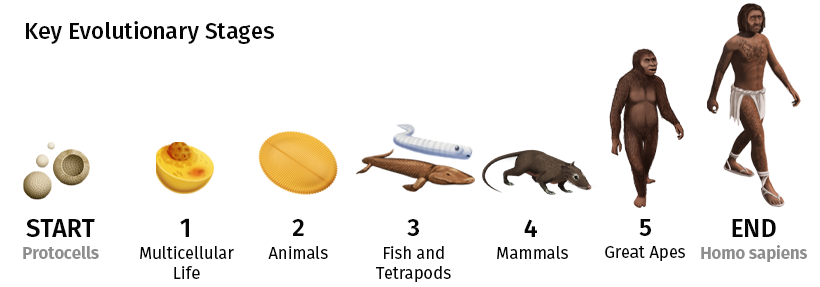
1. Protocells and Early Microorganisms
The first life forms on Earth were simple, single-celled microorganisms known as protocells. These precursor cells lacked a nucleus or other membrane-bound organelles, and they had simple genetic proteins called RNA.
Over time, RNA complexified into the more stable DNA. Protocells slowly developed specialized organelles, becoming more complex microbes that would eventually form eukaryotes – the complex, unicellular organisms that would birth a diverse array of life forms, from simple sponges to complex animals.
2. The First Animals
Dickinsonia is the earliest example of an animal we know of. Though it was a simple, flat creature that lacked a mouth or digestive system, it symbolizes the first multicellular organism of substantial complexity.
Over time, the first sophisticated organ systems began to arise. Bilateral symmetry emerged, as well as early versions of the nervous and circulatory systems. Simple eyes, called eyespots, also appeared around the time that spinal cords and vertebrate creatures began to emerge.
3. Fish and Tetrapods
One of the most significant developments in the evolution of life was the transition from marine to terrestrial environments.
Up until 500 million years ago, all life was sequestered in the sea. Fish were the first vertebrates and introduced additional organs like stomachs, spleens, and body components like scales, teeth, blood, and more. Bony fish arose, and over time their development brought about sophisticated changes to the skeletal system, eventually producing “proto-limbs” that would enable organisms to walk on land.
Researchers are still unsure which specific organism might have first crawled on land, but candidates share these pre-limb characteristics. Tiktaalik is one popular candidate because it had specialized bones that suggest it could support its own weight while moving out of shallow waters.
These creatures eventually became the tetrapods (“four-footed”), and they had features like four-legs, a backbone, and lungs which could absorb oxygen from air. All the amphibians, reptiles, birds, and mammals that followed are descendants of the original tetrapods.
4. The First Mammals
Around 200 million years ago, the first mammals emerged. These early mammals were small, shrew-like creatures that lived alongside the dinosaurs. Over time, however, mammals evolved hair, specialized teeth, sweat glands to regulate body temperature, and a more efficient circulatory system.
Mammals also brought about features like nocturnality, mammary glands, external genitalia, and a variety of other features that distinguished them from other living species at the time, like birds or reptiles.
5. The Great Apes and First Homo Species
Around 7 million years ago, the first great apes emerged in Africa. These apes, such as orangutans, gorillas, and chimpanzees, were highly intelligent and social creatures that lived in complex communities. Over time, one lineage of apes would give rise to the first members of the genus Homo, which includes our own species.
The main developmental changes during this time were the full-time bipedalism of apes, increasing brain size, and advanced bone development that enabled dexterity for tool construction and hunting. Inventions like fire and clothing arose early in the Homo genus, and eventually complex language, hair loss, and dramatic facial changes would evolve.
Researchers struggle with resolving the exact progression of the Homo species. Many Homo species existed at the same time, and since many fossil records overlap, resolving which ones came first is an area of intense focus.
The Future of Human Evolution
As humans continue to evolve, we can expect to see significant changes in our physical and cognitive abilities over the next 10,000 years.
With the rise of technology and the increasing interconnectedness of the world, we may see a shift towards a more globalized and homogeneous human population, with less genetic diversity.
This has been described as “The Great Averaging”, where genetic diversity minimizes and we start to become more alike.
Other theories suggest that we might develop features like a taller, lighter build, with smaller brains and a less aggressive personality.
However, as with all evolution, these changes will be shaped by a complex interplay of genetic, environmental, and cultural factors. It is impossible to predict exactly how humans will evolve over the next 10,000 years, but one thing is certain: the future of human evolution will be shaped by the choices we make today.
Note: This is a complex topic with new research being published all the time. We’ll continue to dynamically update this graphic to reflect the most recent understanding of evolution.
China
How Do Chinese Citizens Feel About Other Countries?
What is the Chinese public’s view of world powers? This visual breaks down Chinese sentiment towards other countries.
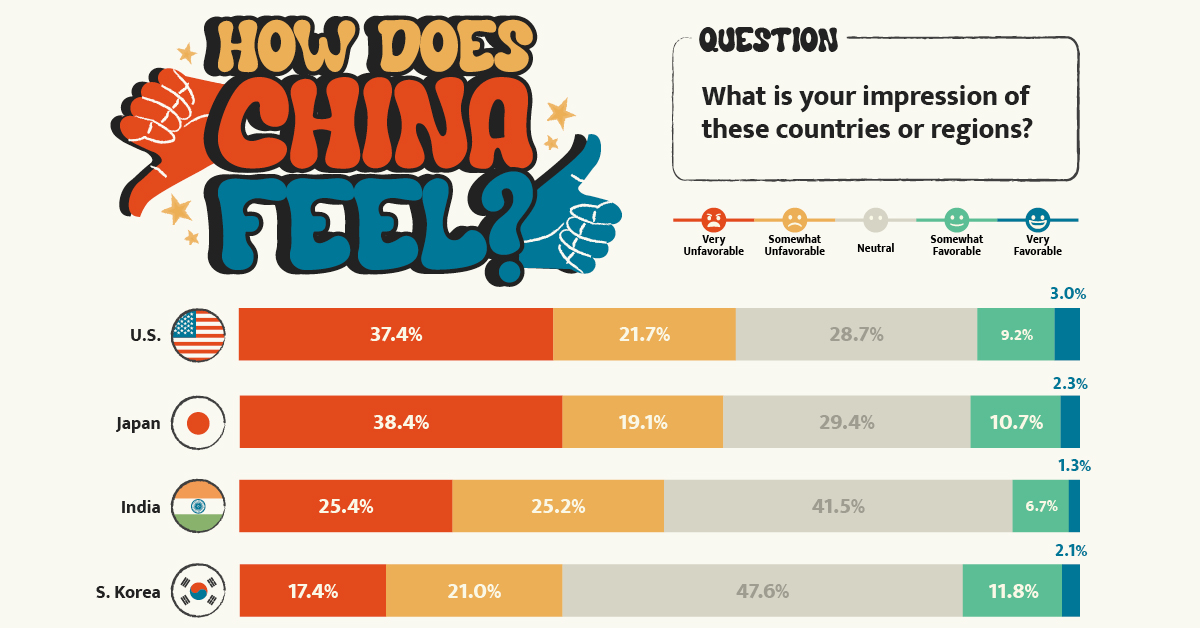
Public Opinion: How Chinese Citizens Feel About Other Countries
Tensions over Taiwan, the COVID-19 pandemic, trade, and the war in Ukraine have impacted Chinese sentiment towards other countries.
This visualization uses data from the Center for International Security and Strategy (CISS) at Tsinghua University to rank survey responses from the Chinese public on their attitudes towards countries and regions around the world.
Chinese Sentiment Towards Other Countries in 2023
In the Center’s opinion polls, which surveyed a random sample of more than 2,500 Chinese mainland adults in November 2022, Russia came out significantly ahead.
Just under 60% of respondents held Russia in a favorable view, with 19% seeing the country as “very favorable.” Contrast that to the mere 12% that viewed the U.S. in a positive light.
Here’s a closer look at the data. The percentages refer to the share of respondents that voted for said category.
| Country/Region | Very Unfavorable | Somewhat Unfavorable | Neutral | Somewhat Favorable | Very Favorable |
|---|---|---|---|---|---|
| 🇺🇸 United States | 37.4% | 21.7% | 28.7% | 9.2% | 3.0% |
| 🇯🇵 Japan | 38.4% | 19.1% | 29.4% | 10.7% | 2.3% |
| 🇮🇳 India | 25.4% | 25.2% | 41.5% | 6.7% | 1.3% |
| 🇰🇷 South Korea | 17.4% | 21.0% | 47.6% | 11.8% | 2.1% |
| 🇪🇺 European Union | 9.3% | 15.6% | 57.6% | 14.1% | 3.3% |
| Southeast Asia | 7.1% | 13.1% | 59.5% | 16.8% | 3.5% |
| 🇷🇺 Russia | 3.0% | 4.8% | 33.7% | 39.4% | 19.0% |
Japan ranked just below the U.S. in terms of overall unfavorability, though a slightly higher share of respondents saw Japan as “very unfavorable” compared to America. This is likely due to both modern tensions in the East China Sea over mutually claimed islands and historical tensions over the Sino-Japanese Wars.
Chinese sentiment towards India was also unfavorable at just over 50%, though notably the country also received the lowest favorability rating at just 8%.
Additional Survey Findings
The survey also found that 39% of Chinese people get their information on international security from Chinese state-run media (mainly through TV), with an additional 19% getting information from government websites and official social accounts. Conversely, only 1.7% get their news from foreign websites and foreign social media, partially due to the Great Firewall.
When asked about different international security issues, the biggest shares of Chinese citizens ranked the following as their top three:
- Pandemics (12.9%)
- Disputes over territory and territorial waters (12.9%)
- China-U.S. relations (12.0%)
The pandemic’s high score reflects the harsher impact COVID-19 had on China. Chinese borders were shut for years and the public faced intense measures to reduce spread.
In terms of other world events, the majority of Chinese people align with a more “Eastern” viewpoint. For example, in regards to the war in Ukraine, the report found that:
“About 80 percent of the respondents believe the U.S. and Western countries should be held most accountable [for the war], while less than ten percent of the respondents argue that Russia is mainly responsible.”– Center for International Security and Strategy, Tsinghua University
Overall, the views of the Chinese public reflect the opposite of those found in many Western countries. They provide an important insight that it is not just the Chinese government holding particular views about the world, but the Chinese public as well.
-

 Economy2 weeks ago
Economy2 weeks agoVisualizing 1 Billion Square Feet of Empty Office Space
-
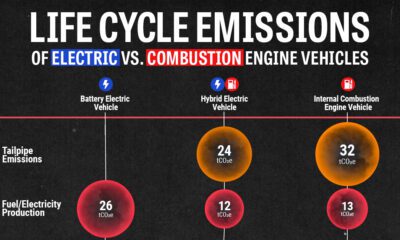
 Green4 weeks ago
Green4 weeks agoLife Cycle Emissions: EVs vs. Combustion Engine Vehicles
-

 Maps2 weeks ago
Maps2 weeks agoVintage Viz: The World’s Rivers and Lakes, Organized Neatly
-

 Finance3 weeks ago
Finance3 weeks agoVisualized: The 100 Largest U.S. Banks by Consolidated Assets
-
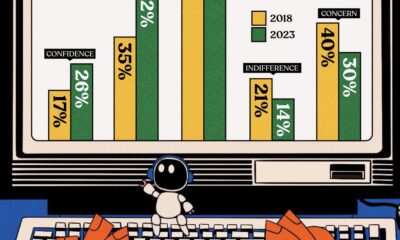
 Technology1 week ago
Technology1 week agoCharted: Changing Sentiments Towards AI in the Workplace
-
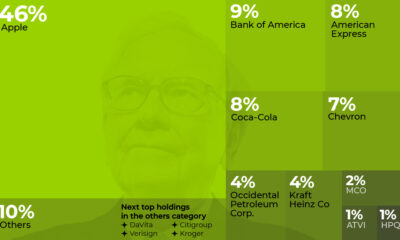
 Markets3 weeks ago
Markets3 weeks agoWhat are Top Investment Managers Holding in Their Portfolios?
-

 Markets1 week ago
Markets1 week agoThe 50 Best One-Year Returns on the S&P 500 (1980-2022)
-

 Markets3 weeks ago
Markets3 weeks agoChart: U.S. Home Price Growth Over 50 Years








